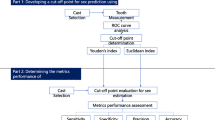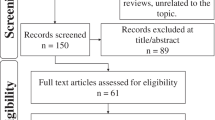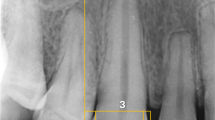Abstract
The mandibular canine index (MCI) has been described as a suitable methodology for sex estimation in forensic scenarios but there are contradictory reports about its accuracy. Moreover, the two mandibular canine teeth must be available, which is not always a viable option. The aim of this study was to strip the MCI by analyzing the MCI itself and its components, in order to optimize its use for sex estimation. The mesiodistal dimensions of the mandibular canine crown and the mandibular canine arch width were measured in a sample of 120 cast models. Five predictor variables were considered in this study: the standard MCI, a variation of the MCI using the left canine, and MCI components (MD43, MD33 and D33–43). Multivariate binary logistic regression was performed using stepwise forward approach to select the most statistical relevant variables on the probability of a cast being from a female. The estimated probability was then analyzed with respect to performance in sex classification (ROC analysis and optimal cut-offs accuracy) and compared with the performance of the univariate variables. MCI43 and MCI33 presented the lowest performance (64.2% and 63.3% respectively), and the highest overall accuracy was attained using the MD43 and MD33 (85.8% in both cases). The multivariate logistic model obtained (using MD43 and MD33) exhibited the same accuracy as the logistic model based solely on MD43 (85.8%). Our results suggest that MD43 should be used instead of MCI for sex estimation.


Similar content being viewed by others
References
Krishan K, Chatterjee PM, Kanchan T, Kaur S, Baryah N, Singh RK. A review of sex estimation techniques during examination of skeletal remains in forensic anthropology casework. Forensic Sci Int. 2016;261(165):e1–8.
Gualdi-Russo E. Sex determination from the talus and calcaneus measurements. Forensic Sci Int. 2007;171:151–6.
Navega D, Vicente R, Vieira DN, Ross AH, Cunha E. Sex estimation from the tarsal bones in a Portuguese sample: a machine learning approach. Int J Legal Med. 2015;129:651–9.
Bidmos MA, Dayal MR. Sex determination from the talus of South African whites by discriminant function analysis. Am J Forensic Med Pathol. 2003;24:322–8.
DeSilva R, Flavel A, Franklin D. Estimation of sex from the metric assessment of digital hand radiographs in a Western Australian population. Forensic Sci Int. 2014;244(314):e1–7.
Monum T, Prasitwattanseree S, Das S, Siriphimolwat P, Mahakkanukrauh P. Sex estimation by femur in modern Thai population. Clin Ter. 2017;168:e203–7.
Robinson MS, Bidmos MA. The skull and humerus in the determination of sex: reliability of discriminant function equations. Forensic Sci Int. 2009;186(86):e1–5.
Koukiasa AE, Eliopoulos C, Manolis SK. Biometric sex estimation using the scapula and clavicle in a modern Greek population. Anthropol Anz. 2017;74:241–6.
Tsubaki S, Morishita J, Usumoto Y, Sakaguchi K, Matsunobu Y, Kawazoe Y, et al. Sex determination based on a thoracic vertebra and ribs evaluation using clinical chest radiography. Leg Med (Tokyo). 2017;27:19–24.
Peckmann TR, Fisher B. Sex estimation from the patella in an African American population. J Forensic Legal Med. 2017;54:1–7.
Kenyhercz MW, Klales AR, Stull KE, McCormick KA, Cole SJ. Worldwide population variation in pelvic sexual dimorphism: a validation and recalibration of the Klales et al. method. Forensic Sci Int. 2017;277(259):e1–8.
Franklin D, Flavel A, Kuliukas A, Cardini A, Marks MK, Oxnard C, et al. Estimation of sex from sternal measurements in a Western Australian population. Forensic Sci Int. 2012;217(230):e1–5.
Torimitsu S, Makino Y, Saitoh H, Ishii N, Yajima D, Inokuchi G, et al. Determination of sex on the basis of hyoid bone measurements in a Japanese population using multidetector computed tomography. Int J Legal Med. 2018;132:907–14.
Franklin D, O'Higgins P, Oxnard CE, Dadour I. Discriminant function sexing of the mandible of indigenous South Africans. Forensic Sci Int. 2008;179(84):e1–5.
Lopez-Capp TT, Rynn C, Wilkinson C, de Paiva LAS, Michel-Crosato E, Biazevic MGH. Discriminant analysis of mandibular measurements for the estimation of sex in a modern Brazilian sample. Int J Legal Med. 2018;132:843–51.
Mestekova S, Bruzek J, Veleminska J, Chaumoitre K. A test of the DSP sexing method on CT images from a modern French sample. J Forensic Sci. 2015;60:1295–9.
Ramsthaler F, Kettner M, Gehl A, Verhoff MA. Digital forensic osteology: morphological sexing of skeletal remains using volume-rendered cranial CT scans. Forensic Sci Int. 2010;195:148–52.
Acharya J, Shrestha R, Shrestha PK, Kanchan T, Krishan K. When protocols become fairy tales and gods remain buried under: excerpts from the diary of forensic experts at ground zero during the mega quake that hit Nepal. Am J Forensic Med Pathol. 2017;38:5–8.
Radlanski RJ, Renz H, Hopfenmuller W. Sexual dimorphism in teeth? Clinical relevance. Clin Oral Investig. 2012;16:395–9.
Ling JY, Wong RW. Tooth dimensions of southern Chinese. Homo. 2007;58:67–73.
Hattab FN, al-Khateeb S, Sultan I. Mesiodistal crown diameters of permanent teeth in Jordanians. Arch Oral Biol. 1996;41:641–5.
Bakkannavar SM, Monteiro FN, Arun M, Pradeep KG. Mesiodistal width of canines: a tool for sex determination. Med Sci Law. 2012;52:22–6.
Viciano J, Lopez-Lazaro S, Aleman I. Sex estimation based on deciduous and permanent dentition in a contemporary Spanish population. Am J Phys Anthropol. 2013;152:31–43.
Rao NG, Rao NN, Pai ML, Kotian MS. Mandibular canine index--a clue for establishing sex identity. Forensic Sci Int. 1989;42:249–54.
Duraiswamy P, Tibdewal H, Patel K, Kumar S, Dhanni C, Kulkarni S. Sex determination using mandibular canine index in optimal-fluoride and high-fluoride areas. J Forensic Dent Sci. 2009;1:99–103.
Silva AM, Pereira ML, Gouveia S, Tavares JN, Azevedo A, Caldas IM. A new approach to sex estimation using the mandibular canine index. Med Sci Law. 2016;56:7–12.
Yadav S, Nagabhushana D, Rao BB, Mamatha GP. Mandibular canine index in establishing sex identity. Indian J Dent Res. 2002;13:143–6.
Muller M, Lupi-Pegurier L, Quatrehomme G, Bolla M. Odontometrical method useful in determining gender and dental alignment. Forensic Sci Int. 2001;121:194–7.
Anuwongnukroh N, Dechkunakorn S, Kunakornporamut K, Tua-Ngam P. Dental arch changes in postretention in class II division 1 extraction cases. Int Orthod. 2017;15:208–20.
Carneiro JL, Santos A, Magalhaes T, Afonso A, Caldas IM. Human identification using dental techniques: a case report. Med Sci Law. 2015;55:78–81.
Acharya AB, Mainali S. Limitations of the mandibular canine index in sex assessment. J Forensic Legal Med. 2009;16:67–9.
Capitaneanu C, Willems G, Jacobs R, Fieuws S, Thevissen P. Sex estimation based on tooth measurements using panoramic radiographs. Int J Legal Med. 2017;131:813–21.
Tuttösí P, Cardoso HFV. An assessment of sexual dimorphism and sex estimation using cervical dental measurements in a northwest coast archeological sample. J Archaeol Sci Rep. 2015;3:306–12.
Acharya AB, Prabhu S, Muddapur MV. Odontometric sex assessment from logistic regression analysis. Int J Legal Med. 2011;125:199–204.
Acknowledgements
This work was partially supported by the Portuguese Foundation for Science and Technology (FCT) – with national (MEC) and European structural funds through the programs FEDER, under the partnership agreement PT2020 - within IEETA/UA project UID/CEC/00127/2013, CIDMA/UA project UID/MAT/04106/2013 and CMUP/UP project UID/MAT/00144/2013. S. Gouveia acknowledges the postdoctoral grant by FCT (ref. SFRH/BPD/87037/2012). All dental casts are the property of the Faculdade de Medicina Dentária do Porto, Portugal, and information regarding these data can be provided upon request.
Author information
Authors and Affiliations
Corresponding author
Ethics declarations
Conflict of interest
The authors declare that they have no conflict of interest.
Ethical approval
The study was approved by the ethics committee of the Faculty of Dental Medicine of the University of Porto, Portugal.
Informed consent
Informed consent was waived as the data used was completely anonymized.
Rights and permissions
About this article
Cite this article
Azevedo, Á., Pereira, M.L., Gouveia, S. et al. Sex estimation using the mandibular canine index components. Forensic Sci Med Pathol 15, 191–197 (2019). https://doi.org/10.1007/s12024-018-0051-2
Accepted:
Published:
Issue Date:
DOI: https://doi.org/10.1007/s12024-018-0051-2




